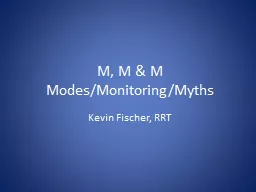

ModesMonitoringMyths Kevin Fischer RRT Disclaimer This presentation is my own This presentation does NOT have the support of any ventilator or manufacturer This presentation is totally made up and not to be reused or copied in any way such as for toilet paper for armed servicesspecial ID: 491445
Download Presentation The PPT/PDF document "M, M & M" is the property of its rightful owner. Permission is granted to download and print the materials on this web site for personal, non-commercial use only, and to display it on your personal computer provided you do not modify the materials and that you retain all copyright notices contained in the materials. By downloading content from our website, you accept the terms of this agreement.
Slide1
M, M & MModes/Monitoring/Myths
Kevin Fischer, RRTSlide2
Disclaimer
This presentation is my own!!
This presentation does NOT have the support of any ventilator or manufacturer
This presentation is totally made up and not to be reused or copied in any way; such as for toilet paper, for armed services/special forces training, for training wild animals, etc.
This presentation is mine – all mine!!!!!Slide3
ModesWhy so many??
Every ventilator manufacturer has it’s “signature” mode. I call it the MODE of the MONTH!! (just like my wine club – two new modes every quarter and for you…… special price!!!)
And many modes are similar in action as well as name/acronym so gets confusingSlide4
Old versus new…….Slide5
Primary modes….
Control ventilation
Pressure ventilation
Volume ventilation
Assist control
SIMV
Pressure support
NIVSlide6
Old modes
CMV
AC
SIMV
PS
These modes worked fine for many years – but didn’t have much flexibility
Did we need newer modes – and if you say yes, why??Slide7
Designer modes
PRVC
APRV
PAV
PPV
HFV
ASV
ATC
NAVABilevel (BiPAP)CPAPTLVPLV
TTFN, TGIF, KMA, SOB, TY, UPS, ASAP, NOC, Slide8
Designer (cont)
Who came up with new modes?
Why?
Do they work?
Who decides which mode to use?
Do you wean from these modes?Slide9Slide10
Pressure vs Volume
My perspective
Pressure ventilation in
neo’s
/
p
ed’s
primary
High frequency in neo’s/ped’s
Otherwise I see geographical/facility preferences.
In the Southeast I saw volume more than pressure in adults
In the Central US I saw a mish-mash of pressure and volume
In the Northwest I saw more pressure usedSlide11
New mode preference
Facility specific
New mode used seemed to be tied directly to training of RT’s
The better the RT staff was trained, when using new ventilators, the more success with designer modes
New mode success seemed to be tied directly to the training of primary intensivist/pulmonologist
New mode success tied to clinical experienceSlide12
New mode preference
There are numerous studies that do show the value of most new modes
The problem is non of the studies show effectiveness in the real world, outside of a controlled environment
Evidence exists that support any mode that is FDA approved – but I am a huge skeptic as
i
am a believer in what I see, what I know, what I practiceSlide13
New mode issues
Training is inconsistent
Staff turnover is a huge issue – lack of consistency
Physician knowledge and support can be lacking
Some facilities have more than one vent manufacturer – vents from different platforms
The ventilator is only as good as the person running itSlide14
Internet access??Slide15
Issues with ANY mode
Lack of RT understanding and comfort with newer modes leads to inconsistent mode management
KNOW IT ALL RTs/physicians/nurses or even worse, know it all manufacturer reps
Lack of management support
Not having SUPER USERS!!!!!Slide16
More issues
One RT knows/uses a specific mode but is replaced at shift change with someone who has a different perspective
Smaller facilities end up purchasing a ventilator from a great sales person – but ends up with a ventilator they do NOT need!!
The modes change faster than my ability to understand them!!Slide17
And sometimes, you didn’t think it through before you bought……Slide18
How do I choose??
First and foremost, use the mode you understand and manage the best. The mode is only as good as you are!!!!! Make sure you understand disease state management as it applies to ventilation
Take training serious!! Make it mandatory!!
With new modes, practice – practice – practice
Please don’t try to manage a mode you don’t understand!! Please don’t be afraid to speak up if you don’t understand a specific mode and ask for more trainingSlide19
Still choosing…….
Make sure you set the PATIENT up for success!!
If pressure works…. Use pressure!!!
If volume works….. Use volume!!
Make sure you understand why a co-worker chooses a specific mode when setting up a vent, or changing modes. Make them explain!!!Slide20
KISS
If a patient has a ventilation issue…. VENTILATE!!!!!!
If a patient has an oxygenations issue….. OXYGENATE!!!!!
If a patient doesn’t need intubated…… DON”T INTUBATE
Please keep ventilation choices simple……Slide21
Monitoring
Traditional monitoring
Cardiac
B/P
RR
ETC02
ETC…….Slide22
Monitoring
New monitoring (maybe not so new but seldom used)
VCO2
Ventilator specific – manufacturers specific toolsSlide23
VCO2
# versus concentration (ETCO2)
Better trending tool
Ability to get actual volumes – dead space
Ability to get VD/VT
Breath to Breath!!!!Slide24
Monitoring
Regardless of parameter, pay attention to trends
Understand how to trust your info
Garbage in, Garbage out……
Use more than one monitoring parameter to create a “triangle” of understanding
Educate your staff – be consistent!!Slide25
In closing…
We are NOT rocket scientists so don’t try to make a rocket!!!
Make decisions based on personal knowledge, comfort, patient condition, patient safety, available resources, etc.
DON’T PUT YOURSELF IN A POSITION OF TRYING TO MANAGE A MODE YOU DON’T UNDERSTAND!! AND DON’T PUT YOUR PATIENTS IN THAT POSITION!! DON’T PUT YOURSELF IN A POSITION OF MONITORING EQUIPMENT, INSTEAD OF PTS!Slide26